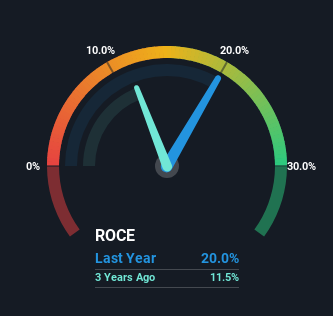- United States
- /
- Food
- /
- NYSE:LW
There Are Reasons To Feel Uneasy About Lamb Weston Holdings' (NYSE:LW) Returns On Capital

If you're not sure where to start when looking for the next multi-bagger, there are a few key trends you should keep an eye out for. Amongst other things, we'll want to see two things; firstly, a growing return on capital employed (ROCE) and secondly, an expansion in the company's amount of capital employed. Put simply, these types of businesses are compounding machines, meaning they are continually reinvesting their earnings at ever-higher rates of return. Having said that, while the ROCE is currently high for Lamb Weston Holdings (NYSE:LW), we aren't jumping out of our chairs because returns are decreasing.
What Is Return On Capital Employed (ROCE)?
For those who don't know, ROCE is a measure of a company's yearly pre-tax profit (its return), relative to the capital employed in the business. Analysts use this formula to calculate it for Lamb Weston Holdings:
Return on Capital Employed = Earnings Before Interest and Tax (EBIT) ÷ (Total Assets - Current Liabilities)
0.20 = US$1.1b ÷ (US$7.2b - US$1.8b) (Based on the trailing twelve months to February 2024).
Thus, Lamb Weston Holdings has an ROCE of 20%. That's a fantastic return and not only that, it outpaces the average of 11% earned by companies in a similar industry.
See our latest analysis for Lamb Weston Holdings

In the above chart we have measured Lamb Weston Holdings' prior ROCE against its prior performance, but the future is arguably more important. If you'd like, you can check out the forecasts from the analysts covering Lamb Weston Holdings for free.
What The Trend Of ROCE Can Tell Us
In terms of Lamb Weston Holdings' historical ROCE movements, the trend isn't fantastic. To be more specific, while the ROCE is still high, it's fallen from 26% where it was five years ago. Although, given both revenue and the amount of assets employed in the business have increased, it could suggest the company is investing in growth, and the extra capital has led to a short-term reduction in ROCE. If these investments prove successful, this can bode very well for long term stock performance.
The Key Takeaway
In summary, despite lower returns in the short term, we're encouraged to see that Lamb Weston Holdings is reinvesting for growth and has higher sales as a result. These trends are starting to be recognized by investors since the stock has delivered a 33% gain to shareholders who've held over the last five years. Therefore we'd recommend looking further into this stock to confirm if it has the makings of a good investment.
One more thing: We've identified 3 warning signs with Lamb Weston Holdings (at least 1 which is concerning) , and understanding them would certainly be useful.
High returns are a key ingredient to strong performance, so check out our free list ofstocks earning high returns on equity with solid balance sheets.
New: AI Stock Screener & Alerts
Our new AI Stock Screener scans the market every day to uncover opportunities.
• Dividend Powerhouses (3%+ Yield)
• Undervalued Small Caps with Insider Buying
• High growth Tech and AI Companies
Or build your own from over 50 metrics.
Have feedback on this article? Concerned about the content? Get in touch with us directly. Alternatively, email editorial-team (at) simplywallst.com.
This article by Simply Wall St is general in nature. We provide commentary based on historical data and analyst forecasts only using an unbiased methodology and our articles are not intended to be financial advice. It does not constitute a recommendation to buy or sell any stock, and does not take account of your objectives, or your financial situation. We aim to bring you long-term focused analysis driven by fundamental data. Note that our analysis may not factor in the latest price-sensitive company announcements or qualitative material. Simply Wall St has no position in any stocks mentioned.
About NYSE:LW
Lamb Weston Holdings
Engages in the production, distribution, and marketing of frozen potato products in the United States, Canada, Mexico, and internationally.
Good value with reasonable growth potential.

